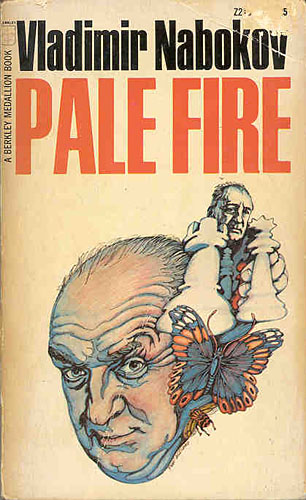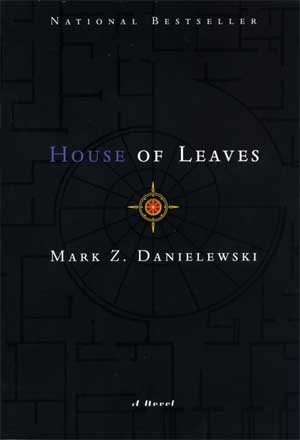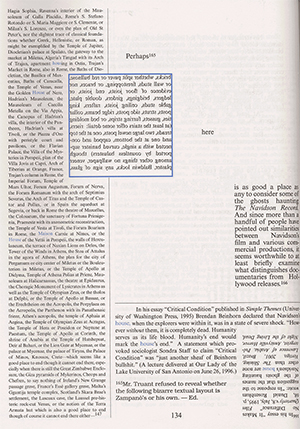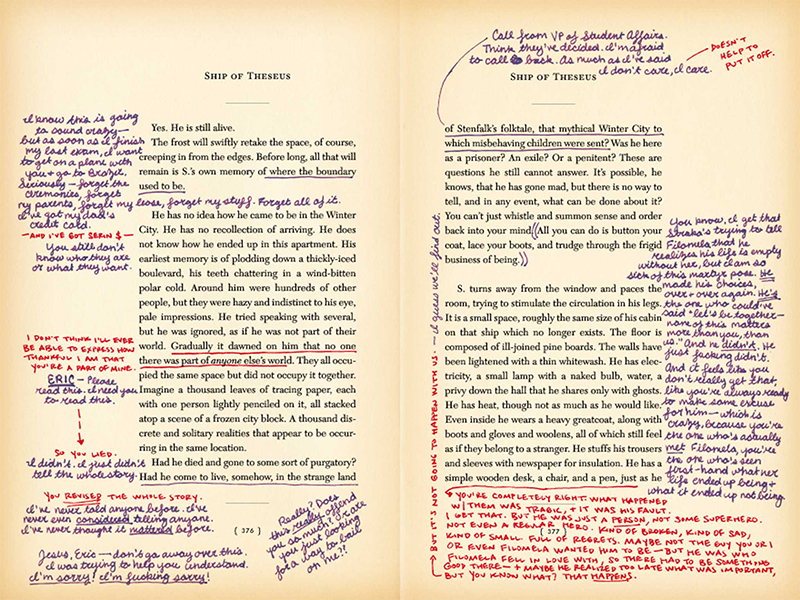I once lent a book to a near-stranger who caught me reading something he liked on my break at work and started chatting me up about books. Usually I find this practice annoying: if you know how good this book is, why are you preventing me from reading it? But the conversation redeemed him, and the next time he came into my café he lent me Joan Didion’s Slouching Toward Bethlehem and I reciprocated with Susan Sontag’s Under the Sign of Saturn.
I have probably never defaced a book more. My pencilings cram the pages, an abundance of my small handwriting along with an embarrassing number of stars and exclamation points. Although I was reading it for an assignment, most of my notes were personal. For this reason I would never have lent it to anyone but a stranger.
Naturally, this exchange led to a peculiar connection between the stranger and me. He also loved Under the Sign of Saturn and read it twice before returning it to me. We traded more books; we began to see each other outside the coffee shop. Our connection was that curious mix of the personal and the impersonal, the intense and the removed, that comes from bonding over art. Later, after we knew each other as well as we ever would — I still don’t know how well that was — he told me that I had inadvertently left something in the Sontag. It had intrigued him, he said, as much as her essays and my exposing notes. Did I know what it was?
I did not.
The object itself — a receipt from a therapy practice with a transparently gay name — was not singularly revealing, and I initially wondered at his response to it. I suspect that what fascinated him more than the facts it suggested was the manner of their discovery. A book, that self-contained little planet, visited by an alien object. Evidence of life outside. These ephemera in books are rare, and on Kindles impossible.
* * *
By now you may have heard of or even handled the book/objet S., conceived by J.J. Abrams — known for Lost and the latest Star Trek films, among other things — and written by novelist Doug Dorst. S. celebrates just this sort of serendipity, the sort that happens neither online nor exactly in the “real world,” but in the leaves of a book. The physical beauty of S., which outside the black case it comes in looks like an old library book called Ship of Theseus, is better conveyed by this bit of promotional book porn than by any description. The tear of the seal, the flash of handwriting in the margins, the unfolding of letters and hand-drawn maps tucked between the pages — these tantalize the sort of reader still devoted to paper books bought in brick-and-mortar stores. S. offers everything in the way of verisimilitude but that old-book must. The postcards look like postcards, the napkin feels like a napkin, the snozzberries taste like snozzberries.
The conceit is that a rogue grad student, Eric, and a college senior, Jen, begin a blind correspondence in the margins of Ship of Theseus, the last novel by one V.M. Straka. Straka’s identity is the mystery at the heart of S. Is he one of several possible contemporaries? A composite of them? A young man who supposedly killed himself in 1910? And what of his relationship with his equally obscure translator? These are the problems our two commentators try to solve in and out of the margins, their own story immediately upstaging the Straka novel. (Straka is based on the still-unidentified author B. Traven, best known for The Treasure of the Sierra Madre; Ship of Theseus is clearly modeled on Traven’s The Death Ship.) Because S. is a book about readers, and one exquisitely peacocking as a book, it’s unsurprisingly billed as “Abrams and Dorst’s love letter to the written word.” That depends what you mean by “the written word,” though. It may be a love letter to the book as object, but S. is weirdly uninterested in the act of reading.
S. is the scion of a particular family of books. There are plenty of metatextual novels, and footnotes in fiction are no longer outré. But S. has at least two notable ancestors in the metafiction subgenre of authorial mystery stories told in pseudoacademic commentary: Vladimir Nabokov’s Pale Fire and Mark Z. Danielewski’s House of Leaves. (A.S. Byatt’s Possession is a close cousin, but the mystery in that novel is not precisely the identity of the authors.)
The three books vary so much in aim, style, and canonical status that it’s almost embarrassing to classify them together. But their similarities are as striking as their differences. Most essential, they are mystery stories about the identities of their authors (although it is easy to read Pale Fire without ever realizing this; spoilers ahead). They also involve primary texts that may or may not have been altered or invented by unreliable narrators. They demand a measure of puzzle-solving and code-cracking. They center around enigmatic men of obscure European background. Their commentaries appear academic in form but parade their authors’ insanity, incompetence, or amateurism.
What’s the purpose of the authorial mystery story, not the whodunit but the whoisit? Books of this form necessarily suggest questions about reader involvement, the importance of the author, and the limits of fiction: why do we care which fictional character “really” wrote something when we know that the name of the true author is always printed on the front cover? How many layers deep does suspension of disbelief penetrate? Why should, and how does, the attribution of a work of art change our experience of it? The commentary format further emphasizes the act of reading. Interpretation, usually something that unfolds outside the book, is itself the subject of the book. In all three novels we watch as our readers-cum-writers are taken over by what they read. These books are formally designed to address reading — but to what end?
 For Nabokov the end is reading well. In his essay “Good Readers and Good Writers,” he envisions great literature as an embrace atop a difficult summit between the “master artist” and the “panting and happy reader.” Pale Fire is more like an Old Testament proof-of-faith in which Nabokov is God. The embedded text is a long poem of the same name, ostensibly by the Robert Frost-like John Shade. The poem’s increasingly zany preface and commentary are attributed to Charles Kinbote, the deposed king of an Eastern European country called Zembla, who is incognito as John Shade’s fellow professor. Except that Kinbote seems to be an invention of the mad Russian Vseslav Botkin, in which case we don’t know where the subfiction stops. Does John Shade exist? Does Zembla? Why does it feel like a cruel trick that the fake country might be fake, when we sportingly accepted its fiction-reality?
For Nabokov the end is reading well. In his essay “Good Readers and Good Writers,” he envisions great literature as an embrace atop a difficult summit between the “master artist” and the “panting and happy reader.” Pale Fire is more like an Old Testament proof-of-faith in which Nabokov is God. The embedded text is a long poem of the same name, ostensibly by the Robert Frost-like John Shade. The poem’s increasingly zany preface and commentary are attributed to Charles Kinbote, the deposed king of an Eastern European country called Zembla, who is incognito as John Shade’s fellow professor. Except that Kinbote seems to be an invention of the mad Russian Vseslav Botkin, in which case we don’t know where the subfiction stops. Does John Shade exist? Does Zembla? Why does it feel like a cruel trick that the fake country might be fake, when we sportingly accepted its fiction-reality?
Pale Fire demands and rewards attentive and obedient readers. To the extent that it is a puzzle — who is Kinbote; what is real? — its solution requires not the appropriate cipher but careful reading, and probably rereading. (It was Nabokov who said, in the essay cited above, “Curiously enough, one cannot read a book: one can only reread it.”) You can’t get anywhere without perusing the index. And the authorial mystery is much easier for the reader to solve — and to notice in the first place — if she follows Kinbote’s officious cross-references (“see, see now, my note to lines . . .”). Brian Walter argues that in Pale Fire Nabokov creates his ideal reader, one who submits completely to the story, accepting the unreliability of the narrator because the point of fiction is unreliability. “To the reader who allows Kinbote to de-familiarize the act of reading,” Walters says, “the work promises a blissful re-familiarization, a renewed appreciation of the gift of literary art.” Nabokov bets that his readers will care even about the details of fictions within fictions, for example the Zemblan crown jewels’ ostentatiously unnamed hiding place, which can also be sleuthed in the index. But why the delight at finding them, when they don’t exist even in the world of the story? Because art is artifice, or, as Nabokov says, “Literature is invention. Fiction is fiction. To call a story a true story is an insult to both art and truth.”
* * *
 House of Leaves proceeds from similar principles and blazes a similarly circuitous trail. In most ways it looks more like S., though. The polyphony is represented through different typefaces (rather than through handwritten marginalia); in its full-color edition the word “house” is always in blue and a certain theme in red; the typography is elaborate and sometimes tortuous. House of Leaves is a text within a text within a text, with appendices. The core Russian doll is a documentary that may or may not exist called The Navidson Record about a house that contains a monstrous, size- and shape-changing labyrinth, into which the eponymous Navidson is lured. Since our medium is the book we cannot actually see the documentary, and learn of it instead through the amateur-academic manuscript of the recently-dead Zampanò — this book’s obscure European, analogue to Kinbote or Straka. The manuscript is in turn transcribed (dubiously) and footnoted (digressively, gonzo-style) by dissolute young Angeleno Johnny Truant. Finally, Truant’s annotated version of the manuscript is presented by “the Editors,” whose appendices include Truant’s letters from his institutionalized mother. And I’m abridging.
House of Leaves proceeds from similar principles and blazes a similarly circuitous trail. In most ways it looks more like S., though. The polyphony is represented through different typefaces (rather than through handwritten marginalia); in its full-color edition the word “house” is always in blue and a certain theme in red; the typography is elaborate and sometimes tortuous. House of Leaves is a text within a text within a text, with appendices. The core Russian doll is a documentary that may or may not exist called The Navidson Record about a house that contains a monstrous, size- and shape-changing labyrinth, into which the eponymous Navidson is lured. Since our medium is the book we cannot actually see the documentary, and learn of it instead through the amateur-academic manuscript of the recently-dead Zampanò — this book’s obscure European, analogue to Kinbote or Straka. The manuscript is in turn transcribed (dubiously) and footnoted (digressively, gonzo-style) by dissolute young Angeleno Johnny Truant. Finally, Truant’s annotated version of the manuscript is presented by “the Editors,” whose appendices include Truant’s letters from his institutionalized mother. And I’m abridging.
Danielewski’s novel is not a love letter to the written word; it’s more like a dare. For him the authorial mystery story is not about good reading but about perilous reading, about the dangers of following a riddle to its elusive solution. Zampanò’s manuscript begins to take over Johnny Truant’s sanity like some nefarious Ray Bradbury creation. The labyrinth in the house has a similar effect on those who encounter it, particularly Navidson, whom it obsesses. That Truant tells us The Navidson Experience doesn’t exist, that he admits to altering Zampanò’s manuscript, that his own existence begins to seem questionable, does not make any piece of the story less chilling. It is the very impossibility of distinguishing fantasy and reality that constitutes the horror in this story. (The eloquent, delusional letters from Truant’s mother may be the creepiest part of the book.) Of course, fiction functions by disabling the distinction between fantasy and reality. Danielewski in his quite different way seeks to “de-familiarize the act of reading,” without the subsequent re-familiarizing. Several clues are written in acrostic, and in one chapter the text itself becomes Morse code. The puzzles contained in House of Leaves tempt us into our own doomed expeditions into the labyrinth of interpretation. The acrostics seem to say, what if these words meant something totally different? What if a story you thought you knew (the minotaur in the labyrinth, for instance) was completely wrong? Interpreting is a futile and insane riddle, Danielewski seems to suggest. Like Navidson, though, we attempt what we know in advance to be dangerous.
 The physical challenges of the book also de-familiarize the act of reading. These books are all demanding; they all require participation. But the participation Nabokov was interested in was not physical. “When we read a book for the first time,” he says in “Good Readers and Good Writers,” “the very process of laboriously moving our eyes from left to right, line after line, page after page, this complicated physical work upon the book, the very process of learning in terms of space and time what the book is about, this stands between us and artistic appreciation.” That’s one reason to reread. Here he differs from Danielewski and Dorst; for them the “complicated physical work upon the book” is fundamental to artistic appreciation. The project of retaining all the inserts in S. is a conspicuous element of the reading experience. The labyrinthine layout of parts of House of Leaves serves, among other purposes, to make the reader work: turn the book, flip back and forth, hold it open before a mirror. But this work serves the larger project of remystifying reading, placing obvious obstacles between the reader and understanding in order to remind us of the less obvious ones. “I wish you to gasp not only at what you read but at the miracle of its being readable,” Kinbote enjoins us. Reading House of Leaves, if we manage to, feels especially miraculous.
The physical challenges of the book also de-familiarize the act of reading. These books are all demanding; they all require participation. But the participation Nabokov was interested in was not physical. “When we read a book for the first time,” he says in “Good Readers and Good Writers,” “the very process of laboriously moving our eyes from left to right, line after line, page after page, this complicated physical work upon the book, the very process of learning in terms of space and time what the book is about, this stands between us and artistic appreciation.” That’s one reason to reread. Here he differs from Danielewski and Dorst; for them the “complicated physical work upon the book” is fundamental to artistic appreciation. The project of retaining all the inserts in S. is a conspicuous element of the reading experience. The labyrinthine layout of parts of House of Leaves serves, among other purposes, to make the reader work: turn the book, flip back and forth, hold it open before a mirror. But this work serves the larger project of remystifying reading, placing obvious obstacles between the reader and understanding in order to remind us of the less obvious ones. “I wish you to gasp not only at what you read but at the miracle of its being readable,” Kinbote enjoins us. Reading House of Leaves, if we manage to, feels especially miraculous.
* * *
In S. the “physical work” serves instead to emphasize the book’s status as an object. There’s nothing inherently wrong in that. I am one of the paper-fondling e-book refuseniks for whom S. is intended. Abrams and Dorst have said that they intended to glorify the tangible in an increasingly virtual era — no surprise there. Part of what excites me about a beautiful book, however, is the expectation of what it contains; there must be something to appreciate beyond the beauty of the page. (Isn’t there a reason we warn not to judge books by their covers?) I found myself most enchanted by S. when I held it at arm’s length and squinted: the promise of the palimpsest, the collision of type and handwriting, the palette of inks! But the promise doesn’t deliver.
It’s not just that S. is not about reading; it’s that it doesn’t care about reading. For one thing, Straka’s novel is boring and vague. It’s hard to believe he has generated his own cadre of specialists fighting to scoop each other on the story of his identity. A fictional critic anticipates this objection in a review, one of S.’s many supplementary online documents, tweeted by Dorst: “The book coaxes readers along a rudderless plod through noxious smoke and warped mirror, replete with inconsistent metaphor and queer, atonal event.” So is Ship of Theseus supposed to be boring and vague?
The answer does not affect the quality of S. The real stories, the ones that happen in the margins and the encoded footnotes added by Straka’s translator, are little better. Just as it’s hard to care about the identity of a mediocre writer, it’s hard to stay invested in the doings of his mediocre interpreters. S. seems to speak to Jen and Eric because they’re bad readers. They see in the most generic pronouncements insights into their own lives. Eric rewards the line “he is not to be taken seriously; he is to be scoffed at and then forgotten” with three exclamation points of recognition. My own readerly indignation flared: this, this is the line that seems to have been written for you? Facile philosophizing on identity sings to Jen and Eric, particularly Jen, for whom graduating from college is the customary crisis. She underlines, “More than anything, he wants to see something familiar, something that connects him, however tenuously, to the world he must have known before he lost his memory, his identity, himself.” Beside these lines she writes, “This is hitting me hard. Everything in my life feels like it’s changing too quickly.” Perhaps we are all trite in the margins of our favorite books, but this sounds like the coughing engine of character development. Her voice seems to have been calibrated to the imagined mean of the coed lit major: “Oh, come on. There’s mad crushing going on here. You know that feeling, don’t you?”
This aspect of her character also begins to grate; being the girl, she sees everything as a love story. (Their own inevitable love story unfolds in flirtations about as ham-handed as the above.) What she and Eric are really interested in is not the novel but the “true story,” and who could blame them? That has nothing to do with literature, however — or it should have nothing to do with literature. Yet they read Ship of Theseus as an encryption of Straka’s life. They match physical descriptions of characters with those of figures in his circle; they seek one-to-one correspondences between events in the novel and those in his history. Occasionally one of them parrots the warning that “not everything a writer writes is about the writer” before disregarding it. Perhaps they’re supposed to be shallow readers. But their success in unraveling the mystery seems to affirm the literalist method.

Along with the novel they read as code, there are the footnotes, which contain actual codes and ciphers. As in House of Leaves, solving them is part of the fun of the experience. (Nabokov wasn’t above the occasional acrostic.) But in House of Leaves decoding is a means to understanding the story, while in S. it is the most interesting part of the story. Where Pale Fire rewards good readers, S. rewards good researchers — or good fans, assiduously following the Twitters, Tumblrs, and verisimilar fake websites disseminating clues to the mysteries left unsolved in analogue. Abrams and Dorst say the paratextual goodies aren’t essential to appreciating the book, but the human drama is just too dull to carry S.; and if the mystery is solvable given the book alone, I leave the task to Will Shortz. This is a book for people who love puzzles, not for people who love novels. If you want a love story in marginalia, see Rebecca Sacks’s “Reading With Louis” in this publication.
S. seems less to celebrate the book than to fetishize it. It misses not only the pleasures of reading, but also one of the chief pleasures of reading-in-analogue, that of holding something relatively self-contained. If your Kindle dies or you’re stranded without Wi-Fi, Pale Fire is all the companion you need. Its puzzles draw you further into the book, not out of it. S., born of nostalgia for a pre-digital age, draws you toward the internet. At this point concern over the death of the book has been surpassed by backlash against that concern. Still, it’s worth thinking about what people fear losing in losing paper books. Surely it has partly to do with absorption in one story. We cannot toggle to a hundred other books or get lost in a warren of hyperlinks. The feel of the paper is not nothing, but the relationship with the story is at the heart of the reading experience.
Abrams gave a popular TED talk on what he calls “the mystery box.” In it he presents a sealed box stamped with a giant question mark, which he tells us he bought in a magic store as a child and never opened. He celebrates the mystery box as a storytelling tool, saying that “there are times when mystery is more important than knowledge.” I agree that sometimes the information withheld is the most compelling part of a story. But the reason an unopened box is compelling is that our experience suggests there is something inside it. The Christmas presents may not live up to the fever of tearing them open, but the sight of the parcels beneath the tree would stop being exciting if last year they had turned out to be empty. That is, even if the box is the most delicious part of the mystery, it has to contain something. Perhaps it’s my bias as an embittered Lost watcher, but I had the same thought approaching the last pages of S. as I did in the last seasons of the show: I don’t care that much what the answer is, but since I’ve gotten this far, there damn well better be one. S. is a beautiful specimen of the mystery box — but tear it open and it’s just pretty paper.
Rachel Luban is a writer currently based in Paris.
This post may contain affiliate links.









